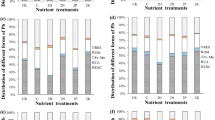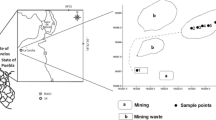Abstract
Compared to traditional chemical or physical treatments, phytoremediation has proved to be a cost-effective and environmentally sound alternative for remediation of contaminated dredged sediment. A field study was conducted in a sediment disposal site predominantly colonized by Typha angustifolia under different sediment moisture conditions to estimate the phytoremediation effects of dredged sediment. The moisture content was 37.30 % and 48.27 % in aerated and waterlogged sediment, respectively. Total nitrogen (TN) content was higher in the waterlogged sediment than in the aerated sediment. The total Cd contents were lower in aerated sediment, which was mainly resulted from the lower exchangeable fraction of Cd. The bioaccumulation of P, Cu and Pb in T. angustifolia was promoted by waterlogging, and the belowground tissue concentrations and accumulation factors (AFs) of Cu were higher than that of other metals, which can be explained by that Cu is an essential micronutrient for plants. Consistent with many previous studies, T. angustifolia showed higher metal levels in roots than in above-ground tissues at both the sediment conditions. Due to the improved biomass produced in the aerated sediment, the removals of nutrients and the metals by plant harvest were higher from aerated sediment than from waterlogged sediment. It was indicated that maintaining the dredged sediment aerated can avoid release risk and plant uptake of metals, while the opposite management option can promote phytoextraction of these contaminants.




Similar content being viewed by others
References
Agunbiade FO, Olu-Owolabi BI, Adebowale KO (2009) Phytoremediation potential of Eichornia crassipes in metal-contaminated coastal water. Bioresour Technol 100:4521–4526
Ali H, Khan E, Sajad MA (2013) Phytoremediation of heavy metals — concepts and applications. Chemosphere 91:869–881
Bao S (2000) Analytical notebook of agricultural chemistry in soil (3rd Edition). Agricultural Publishing House, Beijing (in Chinese)
Bascomb CL (1964) Rapid method for the determination of cation exchange capacity of calcareous and non-calcareous soils. J Sci Food Agric 15:821–823
Bert V, Seuntjens P, Dejonghe W, Lacherez S, Thuy HTT, Vandecasteele B (2009) Phytoremediation as a management option for contaminated sediments in tidal marshes, flood control areas and dredged sediment landfill sites. Environ Sci Pollut R 16:745–764
Bose S, Vedamati J, Rai V, Ramanathan AL (2008) Metal uptake and transport by Typha angustata L. grown on metal contaminated waste amended soil: an implication of phytoremediation. Geoderma 145:136–142
Buykx SE, Bleijenberg M, Van den Hoop MAGT, Gustav LJP (2000) The effects of oxidation and acidification on the speciation of heavy metals in sulfide-rich freshwater sediments using a sequential extraction procedure. J Environ Monit 2:23–27
Cambrollé J, Redondo-Gómez S, Mateos-Naranjo E, Figueroa ME (2008) Comparison of the role of two Spartina species in terms of phytostabilization and bioaccumulation of metals in the estuarine sediment. Mar Pollut Bull 56:2037–2042
Cappuyns V, Swennen R (2005) Kinetics of element release during combined oxidation and pHstat leaching of anoxic river sediments. Appl Geochem 20:1169–1179
Choi JH, Park SS, Jaffé PR (2006) The effects of emergent macrophytes on the dynamics of sulfur species and trace metals in wetland sediments. Environ Pollut 140:286–293
Deng H, Ye ZH, Wong MH (2004) Accumulation of lead, zinc, copper and cadmium by 12 wetland plant species thriving in metal-contaminated sites in China. Environ Pollut 132:29–40
Du Laing G, Rinklebe J, Vandecasteele B, Meers E, Tack FMG (2009) Trace metal behaviour in estuarine and riverine floodplain soils and sediments: a review. Sci Total Environ 407:3972–3985
Eid EM, Shaltout KH, Al-Sodany YM, Soetaert K, Jensen K (2010) Modeling growth, carbon allocation and nutrient budget of Phragmites australis in Lake Burullus, Egypt. Wetlands 30:240–251
Fergusson JE (1990) The heavy elements: chemistry, environmental impact and health effects. Pergamon Press, Oxford
Fitzgerald EJ, Caffrey JM, Nesaratnam ST, McLoughlin P (2003) Copper and lead concentrations in salt mash plants on the Suir Estuary, Ireland. Environ Pollut 123:67–74
Gustavson K, Burton GA, Francingues NR, Reible D, Vorhees DJ, Wolfe JR (2008) Evaluating the effectiveness of contaminated-sediment dredging. Environ Sci Technol 42:5042–5047
Hansel C, Fendorf S, Sutton S, Newville M (2001) Characterization of Fe plaque and associated metals on the roots of mine-waste impacted aquatic plants. Environ Sci Technol 35:3863–3868
Jacob DL, Otte ML (2004) Long-term effects of submergence and wetland vegetation on metals in a 90-year old abandoned Pb–Zn mine tailings pond. Environ Pollut 130:337–345
Kabata-Pendias A, Pendias H (2000) Trace elements in soils and plants, 3rd edn. CRC Press, Boca Raton, FL
King RF, Royle A, Putwain PD, Dickinson NM (2006) Changing contaminant mobility in a dredged canal sediment during a three-year phytoremediaiton trial. Environ Pollut 143:318–326
McGrath SP, Zhao FJ, Lombi E (2001) Plant and rhizosphere processes involved in phytoremediation of metal-contaminated soils. Plant Soil 232:207–214
Nouri J, Khorasani N, Lorestani B, Karami M, Hassani AH, Yousefi N (2009) Accumulation of heavy metals in soil and uptake by plant species with phytoremediation potential. Environ Earth Sci 59:315–323
Peng JF, Song YH, Yuan P, Cui XY, Qiu GL (2009) The remediation of heavy metals contaminated sediment. J Hazard Mater 161:633–640
Pulford ID, Watson C (2003) Phytoremediation of heavy metal contaminated land by trees—a review. Environ Int 29:529–540
Rai PK (2008) Heavy metal pollution in aquatic ecosystems and its phytoremediation using wetland plants: an ecosustainable approach. Int J Phytoremediat 10:133–160
Rai PK (2009) Heavy metal phytoremediation from aquatic ecosystems with special reference to macrophytes. Crit Rev Env Sci Tec 39:697–753
Robinson B, Schulin R, Nowack B, Roulier S, Menon M, Clothier B, Green S, Mills T (2006) Phytoremediation for the management of metal flux contaminated sites. For Snow Landscape Res 80:221–234
Sharma P (2007) Material translocation characteristics and the effect of soil nutrient on the growth of Typha angustifolia. Dissertation, University of Saitama
Stephens SR, Alloway BJ, Parker A, Carter JE, Hodson ME (2001) Changes in the leachability of metals from dredged canal sediments during drying and oxidation. Environ Pollut 114:407–413
Stoltz E, Greger M (2002) Accumulation properties of As, Cd, Cu, Pb and Zn by four wetland plant species growing on submerged mine tailings. Environ Exp Bot 47:271–280
Sutherland RA, Tack FMG (2003) Fractionation of Cu, Pb and Zn in certified reference soils SRM 2710 and SRM 2711 using the optimized BCR sequential extraction procedure. Adv Environ Res 8:37–50
Tessier A, Campbell PGC, Bisson M (1979) Sequential extraction procedure for the speciation of particulate trace metals. Anal Chem 51:844–851
Vermeulen J, Van Gool MPM, Dorleijn AS, Joziasse J, Bruning H, Rulkens WH, Grotenhuis JTT (2007a) Biochemical ripening of dredged sediments: Part 1. Kinetics of biological organic matter mineralization and chemical sulfur oxidation. Environ Toxicol Chem 26:2530–2539
Vermeulen J, van Gool MPM, Mentink GH, Joziasse J, Bruning H, Rulkens WH, Grotenhuis JTT (2007b) Biochemical ripening of dredged sediments: Part 2. Degradation of polycyclic aromatic hydrocarbons and total petroleum hydrocarbons in slurried and consolidated sediments. Environ Toxicol Chem 26:2540–2549
Weis SJ, Weis P (2004) Metal uptake, transport and release by wetland plants: implications for phytoremediation and restoration. Environ Int 30:685–700
Welch RM (1995) Micronutrient nutrition of plant. Crit Rev Plant Sci 14:49
Acknowledgements
This study was supported by National Natural Science Foundation (51108334 and 51278355).
Author information
Authors and Affiliations
Corresponding author
Additional information
Responsible editor: Elena Maestri
Rights and permissions
About this article
Cite this article
Wu, J., Yang, L., Zhong, F. et al. A field study on phytoremediation of dredged sediment contaminated by heavy metals and nutrients: the impacts of sediment aeration. Environ Sci Pollut Res 21, 13452–13460 (2014). https://doi.org/10.1007/s11356-014-3275-z
Received:
Accepted:
Published:
Issue Date:
DOI: https://doi.org/10.1007/s11356-014-3275-z




